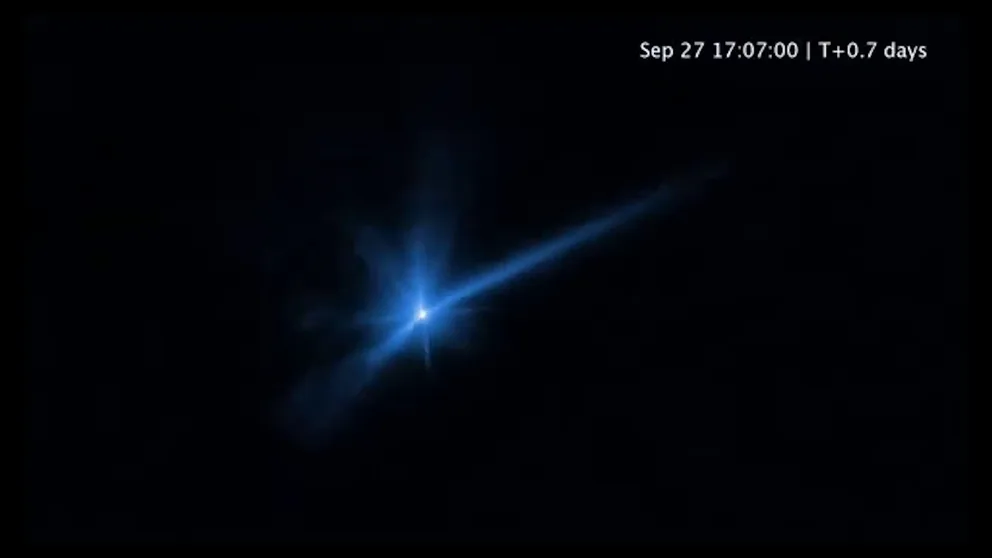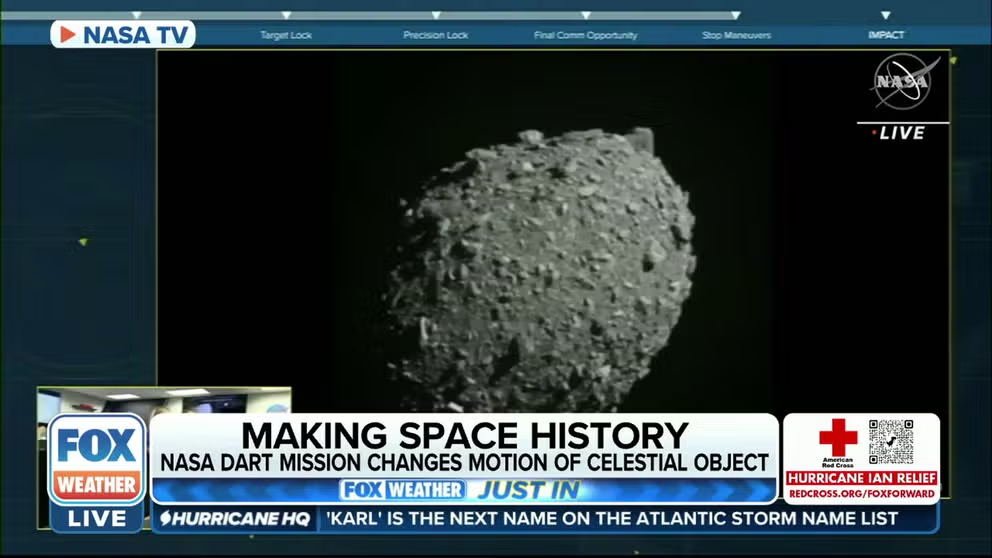Asteroid the size of the Eiffel Tower to have close call with Earth next week
Astronomers say they know exactly how close asteroid 2006 HV5 will get to Earth on April 26: 1.5 million miles, or 6.3 times the distance from the Earth to the Moon.
Watch: New video shows DART asteroid impact debris from Hubble Space Telescope
A video NASA released on Wednesday shows the debris caused by the Double Asteroid Redirection Test (DART) mission spacecraft slamming into the asteroid Dimorphos. (Courtesy: NASA / ESA / STScI / Jian-Yang Li (PSI) / Joseph DePasquale (STScI))
Yes, there is a massive space rock the size of the Eiffel Tower on a close approach to Earth next week. No, there's absolutely no need to panic.
Astronomers say they know exactly how close asteroid 2006 HV5 will get to Earth on April 26: 1.5 million miles, or 6.3 times the distance from the Earth to the Moon.
"That’s plenty of breathing room," Dr. Susanna Kohler with the American Astronomical Society exclaimed.
The close approach of 2006 HV5 is listed as having a rarity of ‘2’ in NASA’s Center for Near Earth Object Studies’ database. According to Kohler, this means that, on average, only once per year does an asteroid of this size or larger approach this close to Earth.
HOW NASA IS WORKING TO PROTECT EARTH FROM AN ASTEROID STRIKE

This artist's illustration of asteroids represents the building blocks of our solar system’s rocky planets.
(NASA)
The asteroid was first spotted in April 2006 as part of the Lincoln Near-Earth Asteroid Research (LINEAR) project, according to Dr. Susanna Kohler with the American Astronomical Society. The LINEAR project is a collaboration of the United States Air Force, NASA and the Massachusetts Institute of Technology's Lincoln Laboratory for the systematic detection and tracking of near-Earth objects.
Kohler said the asteroid is estimated to be around 1,000 feet in diameter, give or take a couple of hundred feet. For perspective, the Eiffel Tower, which is tallest structure in Paris, stands at 1,083-feet tall.
The measurements needed to know what type of asteroid 2006 HV5 is have yet to be discovered, Kohler said.
While 2006 HV5 is reasonably sized, you won’t be able to see it with the naked eye.
"Asteroids don’t emit their own visible light, so we primarily observe them via the sunlight that they reflect," Kohler said. "At its closest approach, 2006 HV5 will still only be bright enough to spot with larger telescopes."
If all this talk of asteroids zooming past Earth has your anxiety levels at an all-time high, you shouldn't be concerned about a planetary strike.
"With 260 observations on the books for 2006 HV5 spanning the last 17 years, astronomers are able to calculate its orbit — and thus its past, present, and future locations — very precisely," she said.
NASA's DART mission
A near-Earth object is classified as any space object that can come within 30 million miles of Earth. For perspective, the Moon is about 238,900 miles from Earth on average.
Most near-Earth objects are asteroids that range in size from about 10 feet to nearly 25 miles across, according to NASA.
NASA DISCOVERS ASTEROID THAT HAS SLIGHT CHANCE OF HITTING EARTH ON VALENTINE'S DAY 2046
NASA's DART mission changes motion of asteroid's orbit
NASA says its first planetary defense test changed an asteroid’s orbit by 32 minutes.
NASA’s NEO Observation Program aims to find, track, and learn about 90% of NEOs that are larger than 140 meters. So far, more than 40% of these asteroids have been found, according to NASA.
If one of these asteroids were to come close, the PDCO would alert the government and the public. According to the PDCO, there is a greater than 1% chance of this happening over the next 50 years.
When the time comes, there is an international plan being studied about how to deflect a massive space rock.
In 2021, NASA launched the Double Asteroid Redirect mission, known as DART. Unlike most NASA spacecraft missions, DART was designed to have a short lifespan and was designed to test out a planetary-defense method that could one day save Earth.
On Sept. 26, 2022, DART used autonomous navigation to hone in on a binary asteroid system – the larger Didymos and its smaller moonlet Dimorphos, about 7 million miles from Earth. Then, it charged at the smaller space rock head first at about 15,000 mph, acting as a battering ram when it crashed into it.
NASA described the mission as a success, saying the DART's collision altered the orbit of the moonlet asteroid. Previously, Dimorphos took almost 12 hours to orbit Didymos. Now, based on ground-based telescope observations, Dimorphos orbits the larger asteroid in 11 hours and 32 minutes.
You can click here to see thousands of asteroids and comets in real-time. You can also watch the next five close approaches to Earth, and explore past, present and future missions to asteroids and comets.

